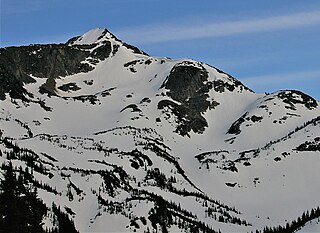
Kwoiek Needle is a 2,625-metre (8,612-foot) mountain summit located in the Lillooet Ranges of southwestern British Columbia, Canada. It is situated 24 km (15 mi) southwest of Lytton, and its nearest higher peak is Kumkan Peak, 9.2 km (6 mi) to the west. The mountain was named in association with Kwoiek Creek, Kwoiek Lake, and Kwoiek Peak. Kwoiek is a Thompson Indian word meaning "gouged out," referring to a large chunk missing from the canyon wall. The name was officially adopted on October 6, 1936, by the Geographical Names Board of Canada. Meltwater from unnamed glaciers on its north slopes and precipitation runoff from the peak drains into Kwoiek Creek and Log Creek, both tributaries of the Fraser River.

Locomotive Mountain is a 2,340-metre (7,680-foot) mountain summit located in the Railroad Group of the Coast Mountains, in the Pemberton Valley of southwestern British Columbia, Canada. It is situated 35 km (22 mi) northwest of Pemberton, 3 km (2 mi) east of Handcar Peak, and 2.1 km (1 mi) south of Face Mountain, which is the nearest higher neighbor. Precipitation runoff from the peak drains into tributaries of the Fraser River. The mountain's name was proposed in 1978 by mountaineer Karl Ricker of the Alpine Club of Canada, in association with Railroad Pass, Railroad Creek, and other railroad-related names of the immediate vicinity. The toponym was officially adopted January 23, 1979, by the Geographical Names Board of Canada.

Mount Tinniswood is a 2,606-metre (8,550-foot) mountain summit located in British Columbia, Canada.

Mount Trorey is a 2,461-metre (8,074-foot) mountain summit located in British Columbia, Canada.

Spearman Peak is a 3,365-metre (11,040-foot) summit located in British Columbia, Canada.

Mount Farrow is a mountain summit in British Columbia, Canada.

Mount Carr is a 2,590-metre (8,497-foot) mountain summit located in British Columbia, Canada.

Handcar Peak is a 2,338-metre (7,671-foot) mountain summit located in the Railroad Group of the Coast Mountains, in the Pemberton Valley of southwestern British Columbia, Canada. It is situated 38 km (24 mi) northwest of Pemberton and 3 km (2 mi) west of Locomotive Mountain. Precipitation runoff from the peak drains into Sampson Creek and Buck Creek which are both tributaries of the Lillooet River. Handcar Peak is more notable for its steep rise above local terrain than for its absolute elevation as topographic relief is significant with the summit rising over 2,050 meters (6,725 ft) above Lillooet River and Pemberton Valley in approximately 4 km (2.5 mi). The mountain's name was proposed in 1978 by mountaineer Karl Ricker of the Alpine Club of Canada, in association with Railroad Pass, Railroad Creek and other railroad-related names of the immediate vicinity. The toponym was officially adopted January 23, 1979, by the Geographical Names Board of Canada.

Face Mountain is a 2,485-metre (8,153-foot) mountain summit located in British Columbia, Canada.

Ipsoot Mountain is a 2,576-metre (8,451-foot) glaciated summit located in southwest British Columbia, Canada.

Phalanx Mountain is a 2,441-metre (8,009-foot) summit located in Garibaldi Provincial Park of southwest British Columbia, Canada.

Isosceles Peak is a 2,488-metre (8,163-foot) mountain summit located in British Columbia, Canada.

Siwhe Mountain is a 2,843-metre (9,327-foot) summit located in British Columbia, Canada.

Vantage Peak is a 2,235-metre (7,333-foot) mountain summit located in the Coast Mountains of British Columbia, Canada. It is part of the Joffre Group, which is a subset of the Lillooet Ranges. It is situated 28.5 km (18 mi) east of Pemberton on the boundary of the Nlháxten/Cerise Creek Conservancy. Precipitation runoff from the peak drains southwest into Twin One Creek thence Lillooet Lake; the north slope drains into headwaters of Cerise Creek; and the east slope drains into Caspar Creek thence Cayoosh Creek which is within the Fraser River watershed. Vantage Peak is more notable for its steep rise above local terrain than for its absolute elevation as topographic relief is significant with the summit rising 1,135 meters (3,724 ft) above Twin One Creek in 4 km (2.5 mi). The nearest higher neighbor is Mount Duke, 2.08 km (1 mi) to the southeast.

Hour Peak is a 2,329-metre (7,641-foot) mountain summit located in British Columbia, Canada.

Parapet Peak is a 2,463-metre (8,081-foot) mountain summit located in British Columbia, Canada.

Kwoiek Peak is a 2,736-metre (8,976-foot) mountain summit located in British Columbia, Canada.

Claimpost Peak is a 2,671-metre (8,763-foot) mountain summit located in British Columbia, Canada.

Haynon Peak is a 2,493-metre (8,179-foot) mountain summit located in British Columbia, Canada.

Shudder Mountain is a 2,671-metre (8,763-foot) summit in British Columbia, Canada.

























